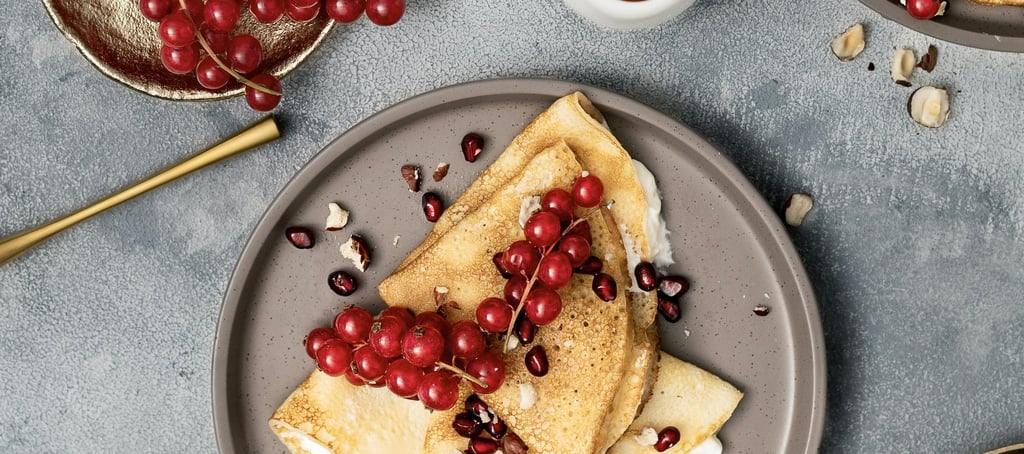

Palacsinta: Hungary’s sweetest childhood memory 🇭🇺✨
Every country has that one dish that instantly takes people back to their childhood. In Italy, it’s nonna’s homemade gnocchi. In the U.S., maybe it’s PB&J sandwiches. But in Hungary? It’s palacsinta—thin, delicate pancakes usually filled with jam, chocolate, or sweet cheese.
I had never even heard of them until last summer when I met Eszter, my Hungarian friend, at a summer program in Milan. One night, while we were sitting on the steps of the Duomo eating way too much gelato, she casually mentioned that her ultimate comfort food was something called palacsinta.
“Like pancakes?” I asked.
“Not really,” she said, dramatically shaking her head. “They’re better.”
I was intrigued. And a few weeks later, Eszter sent me her family’s palacsinta recipe with a voice note saying, “Trust me, this will change your life.” Spoiler alert: she was right.
Palacsinta vs. Pancakes: What’s the difference?
At first glance, palacsinta might look like French crêpes or regular pancakes, but they have their own unique personality.
🥞 American pancakes – Thick, fluffy, and best drowned in maple syrup.
🇫🇷 Crêpes – Super delicate, slightly crispy at the edges.
🇭🇺 Palacsinta – Soft, thin, and endlessly versatile, perfect for sweet or savory fillings.
The key to a great palacsinta? No baking powder! Unlike American pancakes, these don’t puff up. Instead, they stay delicately thin and soft, ready to be filled with anything from apricot jam to Nutella or even cottage cheese mixed with vanilla sugar (which sounds weird but is actually amazing).
My first attempt at making Palacsinta (aka The Pancake Olympics)
Determined to recreate Eszter’s childhood favorite, I woke up on a Saturday morning ready to flip some Hungarian magic. I confidently poured the first ladle of batter into the pan and… disaster. It stuck, it burned, and it looked like a sad tortilla.
Attempt #2? Too thick.
Attempt #3? Flipped too early and folded itself into a weird pancake taco.
By attempt #5, I finally got the hang of it—thin, golden, slightly crispy at the edges, and soft in the center. I spread on apricot jam, rolled it up like Eszter told me to, and took a bite. Instant happiness. ✨
How to make Eszter’s family recipe for Palacsinta
🥞 What You’ll Need:
✔️ 1 cup flour
✔️ 1 cup milk
✔️ ½ cup sparkling water (yes, really—it makes them lighter!)
✔️ 2 eggs
✔️ A pinch of salt
✔️ 1 tbsp sugar
✔️ 1 tbsp melted butter (plus more for frying)
🥄 How to Make It:
1️⃣ Mix the batter: Combine all the ingredients in a bowl and whisk until smooth. The secret is the sparkling water—it makes them extra light and delicate!
2️⃣ Let it rest: Chill the batter for 20-30 minutes. Eszter says this step is “non-negotiable” for perfect texture.
3️⃣ Cook the palacsinta:
• Heat a non-stick pan over medium heat and melt a little butter.
• Pour a small ladle of batter into the pan, swirling it around to coat the bottom.
• Cook for about 1 minute, then flip and cook the other side until lightly golden.
4️⃣ Fill & Roll:
• Spread with apricot jam, Nutella, cinnamon sugar, or sweet cottage cheese.
• Roll them up like a cigar or fold into triangles—there’s no wrong way to eat palacsinta!
5️⃣ Devour immediately because they’re best fresh and warm.
Why you NEED to try this
Palacsinta is one of those foods that instantly makes you feel like a kid again. It’s simple, comforting, and ridiculously easy to love. It also turns out Hungarians are obsessed with them. There’s even a soup version of palacsinta (yes, really—pancake soup is a thing). I sent a picture of my first successful batch to Eszter, and she approved—which means I’m now officially palacsinta-certified. 😎
If you’ve never tried them before, PLEASE make these. Just be warned: once you start making palacsinta, you may never go back to regular pancakes again.
Jó étvágyat! (That’s Bon Appétit in Hungarian!) 🇭🇺✨
